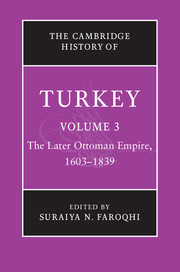Crossref Citations
This Book has been
cited by the following publications. This list is generated based on data provided by Crossref.
Yardumian, Aram
and
Schurr, Theodore G.
2011.
Who Are the Anatolian Turks?.
Anthropology & Archeology of Eurasia,
Vol. 50,
Issue. 1,
p.
6.
Bang, Peter Fibiger
2011.
The Roman Empire in Context.
p.
322.
Kaniewski, David
Van Campo, Elise
and
Weiss, Harvey
2012.
Drought is a recurring challenge in the Middle East.
Proceedings of the National Academy of Sciences,
Vol. 109,
Issue. 10,
p.
3862.
Semerdjian, Elyse
2013.
NAKED ANXIETY: BATHHOUSES, NUDITY, AND THEDHIMMĪWOMAN IN 18TH-CENTURY ALEPPO.
International Journal of Middle East Studies,
Vol. 45,
Issue. 4,
p.
651.
INGRAM, ANDERS
2014.
THE OTTOMAN SIEGE OF VIENNA, ENGLISH BALLADS, AND THE EXCLUSION CRISIS.
The Historical Journal,
Vol. 57,
Issue. 1,
p.
53.
2014.
BOOKS RECEIVED FOR REVIEW.
Bulletin of the School of Oriental and African Studies,
Vol. 77,
Issue. 3,
p.
647.
Matthee, Rudi
2015.
The Decline of Safavid Iran in Comparative Perspective.
Journal of Persianate Studies,
Vol. 8,
Issue. 2,
p.
276.
Michot, Yahya M.
2015.
Sufi Love and Light in Tillo: Ibrāhīm Ḥaqqı Erẓurūmī (d. 1194/1780).
The Muslim World,
Vol. 105,
Issue. 3,
p.
322.
Moudouros, Nikos
2016.
Between anti-Westernization and Islamism: Turkey’s ‘Islamic’ vision in Cyprus?.
Southeast European and Black Sea Studies,
Vol. 16,
Issue. 2,
p.
317.
2016.
Glauben im Hinterland.
p.
550.
Shaw, Malcolm
2016.
The League of Nations Mandate System and the Palestine Mandate: What Did and Does It Say about International Law and What Did and Does It Say about Palestine?.
Israel Law Review,
Vol. 49,
Issue. 3,
p.
287.
IWAMOTO, Keiko
2017.
From Tax-exempt to Tax-paying.
Bulletin of the Society for Near Eastern Studies in Japan,
Vol. 59,
Issue. 2,
p.
200.
Soares, Marina de Oliveira
2017.
O harém ao rés do chão: imaginário europeu e representações médicas sobre o lugar-segredo, 1599-1791.
Işıksel, Güneş
2018.
The Encyclopedia of Diplomacy.
p.
1.
Davide, Trentacoste
2021.
Grand Ducal ambitions and Venetian counter-intelligence. The Tuscan failure in the 1607 attack on Cyprus..
Revista Historia Autónoma,
p.
59.
Arıkanlı, Zeynep
2022.
Turkish-French Relations.
p.
3.
Yıldız, Aysel
2022.
Janissaries and Urban Notables in Local Politics: Struggle for Power and Factional Strife in the Late Eighteenth-Century Anatolian Town of Adana.
Histories,
Vol. 3,
Issue. 1,
p.
1.





